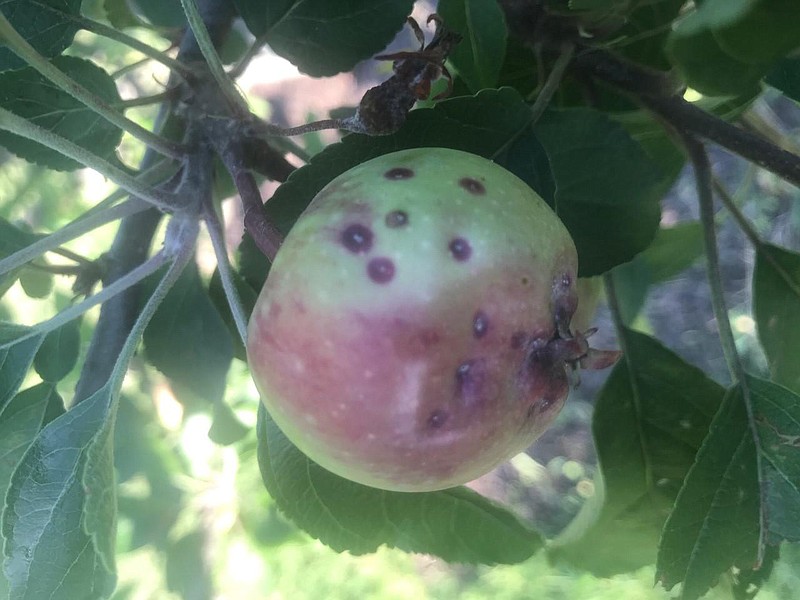Q. What is this disease (see photo)? It often gets our apples. I thought it was apple scab, but we spray a fungicide when we can. We don't when they flower because we have bees. What can we do this year and any suggestions for future years?
A: I think it is apple scab, but it could be cedar apple rust at the early stages. If it becomes obviously 'scabby' and black later, then yes, it is. I also don't see the typical orange spots of rust on the leaves. Timing of fungicide sprays is critical, and during flowering is one of those infectious times. To spare your bees, spray a fungicide in the evening. It will dry overnight and should be safe for them the next morning. Never apply an insecticide to flowering fruit trees (but I think you know that).
University of Missouri Extension's fruit spray guide lists scab under 'summer cover sprays' (June through mid-August) at 14-day intervals. So continued applications of a fungicide could limit the severity of the disease development. Captan is a recommended fungicide. For more information, see extension2.missouri.edu/g6010 .
Q. I'm new at gardening. Something is eating my cabbage; it's getting all these holes. What can I use to stop it? I only have a few plants. I'd like something safe and easy to use.
A: The most likely culprit is some type of cabbage worms or caterpillars. The simplest way to prevent and stop them would be a product like Dipel Dust. You just sprinkle it on, but you need to reapply if rain washes it off (about inch probably will). It is an effective and natural product and generally pretty cheap. Please read the label for complete information.
Q. I really like gingko trees and wanted to plant one to quickly shade an area outside my picture window. Can I still plant one this year?
A: One can plant a tree in Missouri this late if you make sure to water it through any dry spells. Given the soil moisture is quite good, this year should be fine. Make sure to do a good job with the soil preparation though.
Now for the disappointing news. Gingko is not the tree to plant for gaining shade value from it, at all quickly. I would consider other trees. Discuss this with a knowledgeable person at a garden center. Also helpful is this University of Missouri Extension publication as it is specific to Missouri. For quick shading, focus your choice on 'fast' growing, or, at minimum, medium growth rate.
extension2.missouri.edu/g6800 (Selecting Landscape Plants: Shade Trees).
Q. I don't think my first attempt at a raised bed worked well. It is a small area. How do you recommend to install a raised bed: take out the sod, till? Add rocks? What kind of dirt, compost, etc?
A: I would keep the sod, but kill it first. An easy way to kill it given two months or longer, is to smother it with plastic and something that blocks the light completely. One can also apply a systemic herbicide like glyphosate (aka Roundup). Two applications about two to three weeks apart work well. This will have the sod completely dead within a month.
Now till up the 'native' soil (and dead sod) very well, to a depth of 8-10 inches. Then incorporate amendments to improve it, based on a soil test. To increase organic content, adding and till in 3-4 inches of peat moss would be good. Then add a shallow layer of any soil that you are purchasing or building it up with (about 2-3 inches). Till that layer into the (now improved) 'native soil'. Then, add more of this purchased soil on top. At this point, you'd need to add about 3 inches to have a raised bed up about 6 inches high.
Any purchased soil or dirt is a big question and challenge. For a small raised bed, the safest/easiest route to go is to purchase bagged soil that is labeled as good for growing plants in. Many retailers are now selling a product called 'garden soil' that should work fairly well. Potting soil could also be used. If you killed the sod chemically, you could get a fall garden in or plant a cover crop like buckwheat and oats. If you tarp to kill it, then you could still get a fall cover crop on. A cover crop will help the soil to blend together for next spring.

